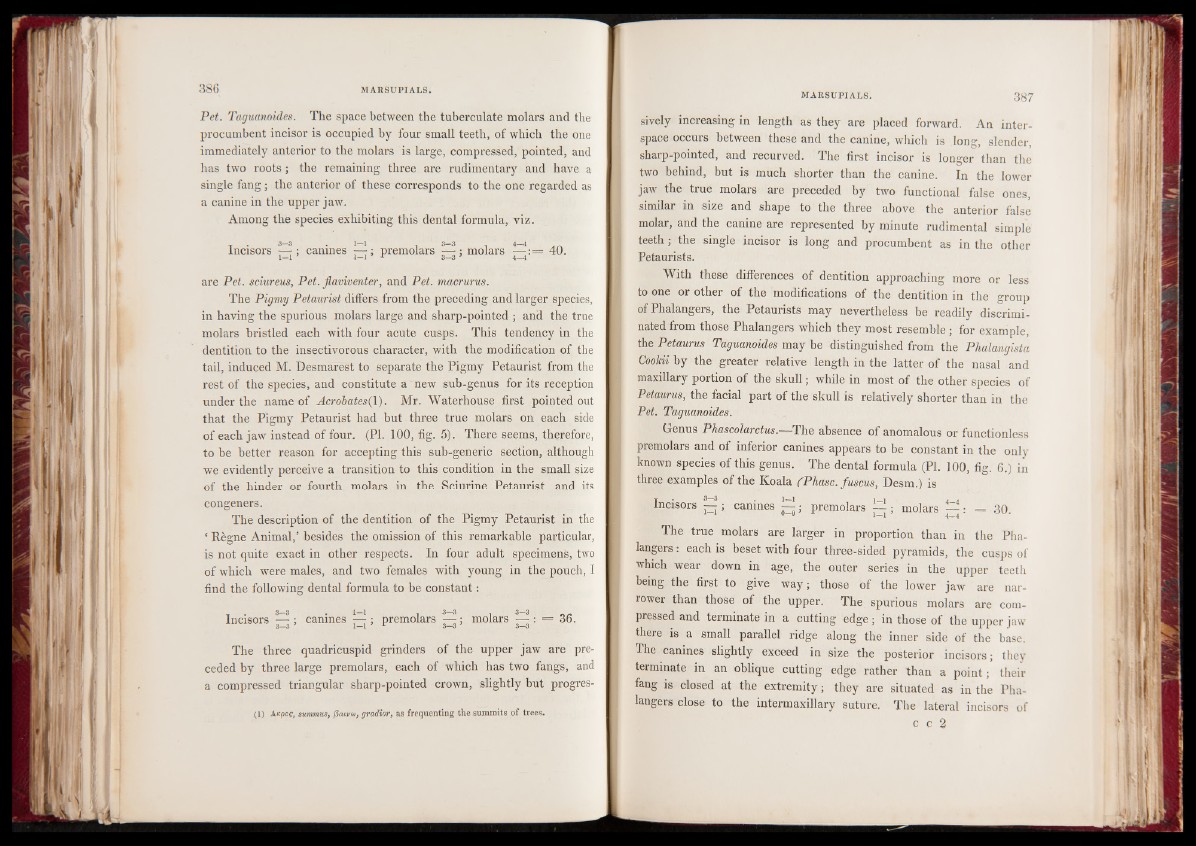
386 MARSUPIALS.
Pet. Taguanoides. The space between the tuberculate molars and the
procumbent incisor is occupied by four small teeth, of which the one
immediately anterior to the molars is large, compressed, pointed, and
has two roots ; the remaining three are rudimentary and have a
single fang ; the anterior of these corresponds to the one regarded as
a canine in the upper jaw.
Among the species exhibiting this dental formula, viz.
Incisors — ; canines premolars — : molars = 40.
are Pet. sciureus, Pet. jiaviventer, and Pet. macrurus.
The Pigmy Petaurist differs from the preceding and larger species,
in having the spurious molars large and sharp-pointed ; and the true
molars bristled each with four acute cusps. This tendency in the
dentition to the insectivorous character, with the modification of the
tail, induced M. Desmarest to separate the Pigmy Petaurist from the
rest of the species, and constitute a new sub-genus for its reception
under the name of Acrobates( 1). Mr. Waterhouse first pointed out
that the Pigmy Petaurist had but three true molars on each side
of each jaw instead of four. (PL 100, fig. 5). There seems, therefore,
to be better reason for accepting this sub-generic section, although
we evidently perceive a transition to this condition in the small size
of the hinder or fourth molars in the Sciurine Petaurist and its
congeners.
The description of the dentition of the Pigmy Petaurist in the
‘ Règne Animal,5 besides the omission of this remarkable particular,
is not quite exact in other respects. In four adult specimens, two
of which were males, and two females with young in the pouch, I
find the following dental formula to be constant :
Incisors «—_o ; canines —1—1 ; premolars 3— -3 ; molars 3—__3 : == 36. 3—3 1—1 3—3 3—3
The three quadricuspid grinders of the upper jaw are preceded
by three large premolars, each of which has two fangs, and
a compressed triangular sharp-pointed crown, slightly but progres- 1
(1) AKpof, summits, fiaivtu, gradior, as frequenting the summits of trees.
MARSUPIALS. 387
sively increasing in length as they are placed forward. An interspace
occurs between these and the canine, which is long, slender,
sharp-pointed, and recurved. The first incisor is longer than the
two behind, but is much shorter than the canine. In the lower
jaw the true molars are preceded by two functional false ones,
similar in size and shape to the three above the anterior false
molar, and the canine are represented by minute rudimental simple
teeth; the single incisor is long and procumbent as in the other
Petaurists.
With these differences of dentition approaching more or less
to one or other of the modifications of the dentition in the group
of Phalangers, the Petaurists may nevertheless be readily discriminated
from those Phalangers which they most resemble | for example,
the Petaurus Taguanoides may be distinguished from the Phalangista
Cookii by the greater relative length in the latter of the nasal and
maxillary portion of the skull; while in most of the other species of
Petaurus, the facial part of the skull is relatively shorter than in the
Pet. Taguanoides.
Genus Phascolarctus. —The absence of anomalous or functionless
premolars and of inferior canines appears to be constant in the only
known species of this genus. The dental formula (Pl. 100, fig. 6.) in
three examples of the Koala CPkasc. fuscus, Desm.) is
Incisors — ; canines ^ ; premolars ^ ; molars 4~ : = 3 0 .
The true molars are larger in proportion than in the Phalangers
: each is beset with four three-sided pyramids, the cusps of
which wear down in age, the outer series in the upper teeth
being the first to give way; those of the lower jaw are narrower
than those of the upper. The spurious molars are compressed
and terminate in a cutting edge; in those of the upper jaw
there is a small parallel ridge along the inner side of the base.
The canines slightly exceed in size the posterior incisors; they
terminate in an oblique cutting edge rather than a point; their
fang is closed at the extremity; they are situated as in the Phalangers
close to the intermaxillary suture. The lateral incisors of